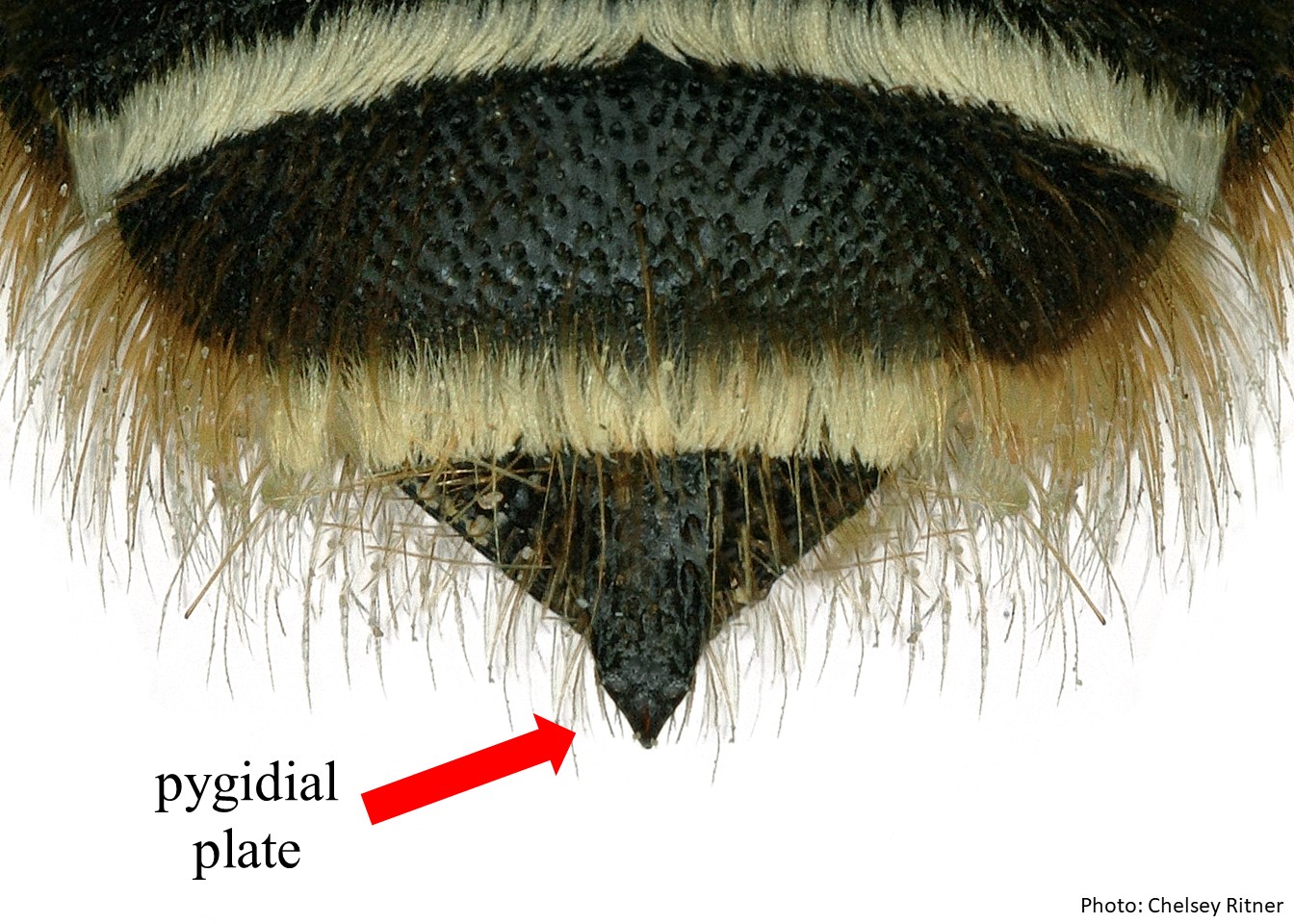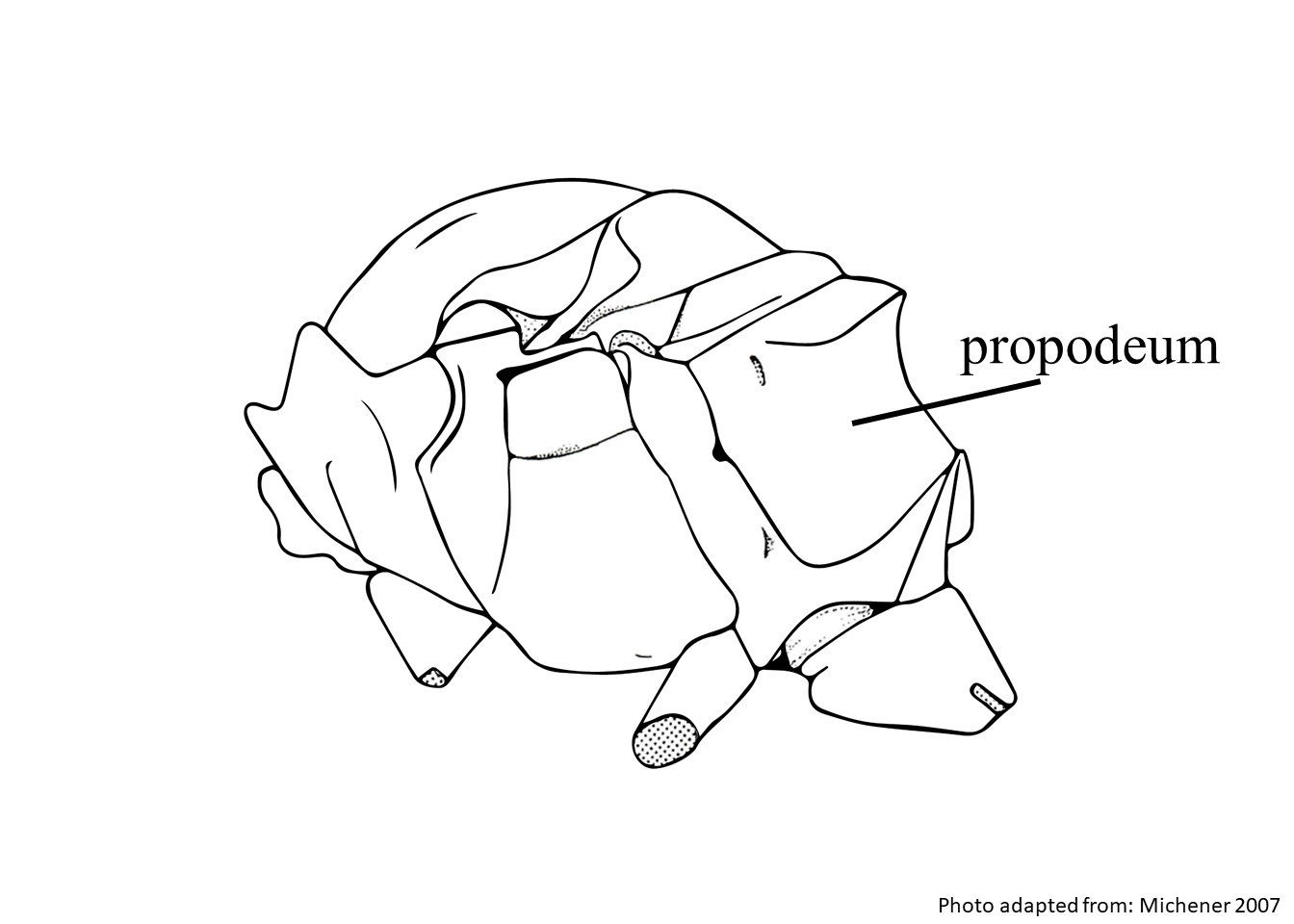Taxonomy
Family: Apidae
Subfamily: Xylocopinae
Tribe: Xylocopini
Genus: Xylocopa
Subgenus: Proxylocopa, Hedicke 1938
Common name: Carpenter bee
Background
Xylocopa (Proxylocopa) are small to medium sized bees, 10 – 25 mm in length, with reddish brown to black integumentintegument:
a tough, protective outer layer
. They have thick, primarily pale, pubescencepubescence:
short, fine hair
that forms apicalapical:
near or at the apex or end of any structure
bands on the tergaterga:
the segments on the top side of the abdomen, often abbreviated when referring to a specific segment to T1, T2, T3, T4, T5, T6, or T7
 . Their wings are clear to slightly brown in color (Hurd and Moure 1963Hurd and Moure 1963:
. Their wings are clear to slightly brown in color (Hurd and Moure 1963Hurd and Moure 1963:
Hurd, P.D. and J.S. Moure. 1963. A Classification of the Large Carpenter Bees (Xylocopine) (Hymenoptera: Apoidea). University of California Publications in Entomology (Vol. 29). Berkeley and Los Angeles: University of California Press, 365 pp.).
Diversity
Xylocopa (Proxylocopa) includes 13 species (Ascher and Pickering 2022Ascher and Pickering 2022:
Ascher, J.S. and J. Pickering. 2022. Discover Life bee species guide and world checklist (Hymenoptera: Apoidea: Anthophila). https://www.discoverlife.org/mp/20p?see=Nodulaamp;name=Xylocopaamp;flags=subgenus:).
Distribution
Xylocopa (Proxylocopa) are known from desert areas from the eastern Mediterranean through the Middle East to Western China (Michener 2007Michener 2007:
Michener, C.D. 2007. The Bees of the World (2nd ed.). Johns Hopkins University Press, Baltimore and London, 953 pp.).

Distribution map generated by Discover Life -- click on map for details, credits, and terms of use.
Host associations
Members of Xylocopa (Proxylocopa) are known to be generalist pollinators and have been observed visiting the flowers of the plant families: Asteraceae, Cardueae, Fabaceae, and Lamiaceae (Terzo et al. 2007Terzo et al. 2007:
Terzo M., S. Iserbyt, and P. Rasmont. 2007. Reacute;vision des Xylocopinae (Hymenoptera: Apidae) de France et de Belgique. Annales de la Socieacute;teacute; Entomologique de France 43 (4): 445‒491.). They are also known pollinators of a number of agricultural species such as alfalfa, chickpea, licorice, peanut, pea, red clover, sainfoin, and soybean (Özbek 2013Ouml;zbek 2013:
Ouml;zbek, H. 2013. New Data on Large Carpenter-bees of Turkey with Considerations About Their Importance as Pollinators. Journal of Entomological Research Society 15(1): 79-89.).
Diagnostic characteristics
(modified from Hurd and Moure 1963Hurd and Moure 1963:
Hurd, P.D. and J.S. Moure. 1963. A Classification of the Large Carpenter Bees (Xylocopine) (Hymenoptera: Apoidea). University of California Publications in Entomology (Vol. 29). Berkeley and Los Angeles: University of California Press, 365 pp. and Minckley 1998Minckley 1998:
Minckley, R. L. 1998. A Cladistic Analysis and Classification of the Subgenera and Genera of the Large Carpenter Bees, Tribe Xylocopini (Hymenoptera: Apidae). Natural History Museum, The University of Kansas 9: 1-47.)
- Basitibial plate basitibial plate:
a small plate at the base of the hind tibia, like a kneecap
 present and at or before the basalbasal:
present and at or before the basalbasal:
originating at the foundation of a structure
one-fourth of the tibiatibia:
the segment of the leg, between the femur and the tarsus
 .
.
- Parapsidal line parapsidal line:
the line that runs submedially along the scutum and corresponds to the median border of the site of origin for flight muscles
 short, at most three times as long as broad, situated anterioranterior:
short, at most three times as long as broad, situated anterioranterior:
toward the head or on the head side of a segment being described
to posterior end of median scutal line.
- Scutellum scutellum:
shield shaped plate behind scutum
 convexconvex:
convexconvex:
curved outward
in profile.
- Male hind tibiatibia:
the segment of the leg, between the femur and the tarsus
 with two apicalapical:
with two apicalapical:
near or at the apex or end of any structure
spines.
- Female pygidial platepygidial plate:
unusually flat area (a plate) surrounded by a ridge or line and sometimes sticking well off of the end of the bee; if present, found on the sixth upper abdominal segment in females, seventh in males
 without subapicalsubapical:
without subapicalsubapical:
located just behind the apex of the segment or body part
laterallateral:
relating, pertaining, or attached to the side
spines.
- Female propodealpropodeal:
the last segment of the thorax
 triangle absent.
triangle absent.
May be confused with
Xylocopa (Proxylocopa) is most similar to X. (Xylocopa) and some authors have suggested placing it within that subgenus (
Hurd and Moure 1963Hurd and Moure 1963:
Hurd, P.D. and J.S. Moure. 1963. A Classification of the Large Carpenter Bees (Xylocopine) (Hymenoptera: Apoidea). University of California Publications in Entomology (Vol. 29). Berkeley and Los Angeles: University of California Press, 365 pp.). X. (Proxylocopa) can be distinguished by their short parapsidal lines, the male with two
apicalapical:
near or at the apex or end of any structure
spines on its hind
tibiatibia:
the segment of the leg, between the femur and the tarsus

, and the female with
basitibial platebasitibial plate:
a small plate at the base of the hind tibia, like a kneecap

arising in the
basalbasal:
originating at the foundation of a structure
one-fourth of the
tibiatibia:
the segment of the leg, between the femur and the tarsus

.
Nesting behavior
The nesting behavior of Xylocopa (Proxylocopa) is unique among carpenter bees as they are known to dig burrows. After mating, females form communal nests in clay-rich soil with 3-6 cells each. One egg is laid in each cell and supplied with pollen and nectar for the future hatchling (
Gottlieb et al. 2005Gottlieb et al. 2005:
Gottlieb, D., T. Keasar, A. Shmida, and U. Motro. 2005. Possible Foraging Benefits of Bimodal Daily Activity in Proxylocopa olivieri (Lepeletier) (Hymenoptera: Anthophoridae). Environmental Entomology 34(2): 417-424.).
Known invasives
There are no known invasives.
References
Ascher, J.S. and J. Pickering. 2022. Discover Life bee species guide and world checklist (Hymenoptera: Apoidea: Anthophila). Discover Life. https://www.discoverlife.org/mp/20p?see=Proxylocopa&name=Xylocopa&flags=subgenus:
Gottlieb, D., T. Keasar, A. Shmida, and U. Motro. 2005. Possible Foraging Benefits of Bimodal Daily Activity in Proxylocopa olivieri (Lepeletier) (Hymenoptera: Anthophoridae). Environmental Entomology 34(2): 417-424.
Michener, C.D. 2007. The Bees of the World (2nd ed.). Johns Hopkins University Press, Baltimore and London, 953 pp.
Minckley, R.L. 1998. A Cladistic Analysis and Classification of the Subgenera and Genera of the Large Carpenter Bees, Tribe Xylocopini (Hymenoptera: Apidae). Natural History Museum, The University of Kansas 9: 1-47.
Özbek, H. 2013. New Data on Large Carpenter-bees of Turkey with Considerations
About Their Importance as Pollinators. Journal of the Entomological Research Society 15(1): 79-89.
Terzo, M., S. Iserbyt, and P. Rasmont. 2007. Révision des Xylocopinae (Hymenoptera: Apidae) de France et de Belgique. Annales de la Société Entomologique de France 43(4): 445-491.
 . Their wings are clear to slightly brown in color (Hurd and Moure 1963Hurd and Moure 1963:
. Their wings are clear to slightly brown in color (Hurd and Moure 1963Hurd and Moure 1963:
 without subapicalsubapical:
without subapicalsubapical: